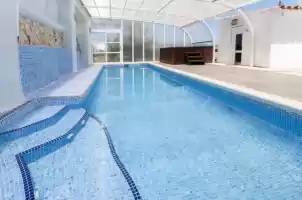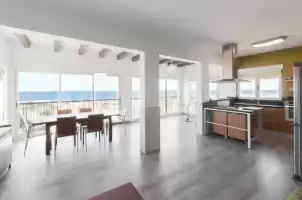Welcome to Chelva, a picturesque village located in the region of Los Serranos, the first of the Valencian Community to be declared a Biosphere Reserve by UNESCO, also known as Alto Turia.
If you are thinking of planning a holiday in the Valencian Community, you are probably looking for a beach destination such as Denia or Cullera. However, we recommend a stay of several days to discover small hidden gems inland, such as the one we are going to show you today.
At first glance, Chelva may appear to be just another rural destination, but behind its modest cobbled streets and architectural heritage lies a rich history and a host of charms to discover. It’s a recommended place to visit from spring onwards, as winter is in full force in this region. The narrow labyrinths of streets that make up the old town of Chelva come alive from this season onwards, as in times gone by when Christians, Jews and Arabs coexisted in peace and harmony in this town.

Exploring the medieval architecture of Chelva
Chelva’s history dates back to Iberian times, but it was during the Muslim domination that the town reached its splendour. Witness to this golden age is the imposing Castillo de Chelva, a stone fortress that rises above the skyline as a guardian of history. From its battlements, visitors can take in the panoramic views of the surrounding countryside and be carried away by the grandeur of the past.
Within the old town of Chelva, the labyrinthine cobbled alleys reveal important architectural treasures. You can follow a route called “Las Tres culturas de Chelva” (The Three Cultures of Chelva) with an extension of approximately 2 kilometres which allows you to discover the main historic quarters of the town:
- Andalusian quarter of Benacacira: The old Arab medina of Chelva, built between the 11th and 12th centuries, is distinguished by its picturesque arcades, whitewashed houses and narrow cul-de-sacs.
- Jewish quarter of Azoque: The alleys of the Jewish quarter of Chelva maintain the mystery and charm of the old medieval aljamas. To walk through them is to embark on an authentic journey into the town’s past.
- Moorish-Mudejar quarter of Arrabal: This quarter, which takes its name from its location on the outskirts of the walled enclosure of Chelva during the 14th century, is home to outstanding monuments such as the Ermita de los Desamparados and the Ermita de la Santa Cruz, which was once the Mosque of Banaeça.
- Christian quarter of La Ollería: Also dating from the 14th century, this quarter owes its name to the numerous pottery kilns that populated its streets in times gone by.
As we walk through the old quarter of Chelva, we can discover the Archpriestly Church of Nuestra Señora de los Ángeles.

This impressive 15th century Valencian Gothic masterpiece, built on the remains of a former mosque, is a testament to the region’s rich cultural heritage.
Another outstanding monument is the Palacio Vizcondal, an architectural jewel dating from the end of the 14th century, which served as the residence of the Viscount of Chelva. This palace houses the 12th century Almohad Alcazar, which marked the starting point for the architectural evolution of the building into the imposing edifice that dominates the Plaza Mayor today. Recently, a fascinating discovery has been made: evidence has been found of an Iberian occupation dating back to the 4th century BC, and it has been confirmed that, in the 13th century, Chelva’s first Christian church was erected within the castle walls.
The Chelva Water Route
The Chelva Water Route offers much more than just a simple path; it is a journey through time and an encounter with the very essence of life, where water, nature and history intertwine to create an unforgettable experience, ideal for families with children.

This circular tourist route harmoniously combines nature and culture in a pleasant stroll. It starts in the Plaza Mayor and descends towards the river, from there, let yourself be guided by the signs that indicate the paths to follow.
Throughout the municipality, visitors can enjoy the crystal-clear waters of the river of Chelva while they enjoy a peaceful stroll, contemplating springs, fountains and old washing places.

This route also offers the opportunity to appreciate the Roman aqueduct of Peña Cortada, declared an Asset of Cultural Interest, this colossal work of hydraulic engineering was built by the Romans in the 1st century AD. The aqueduct is one of the most important in the country and preserves sections along 28km. The most spectacular elements are: the Rambla de Alcotas Bridge, the Barranco del Gato Bridge and the Peña Cortada, an impressive vertical cut followed by a gallery carved into the rock that can be walked along.

Immersing ourselves in the local culture of Chelva
But Chelva is not just about history and architecture; it is also a place where local culture and traditions are very much alive. If you visit Chelva during Holy Week, you can witness impressive religious processions through the streets of the town, accompanied by music and religious fervour.
On 30 April, the festival of “Los Mayos” is celebrated. During this festival, the “Rondalla de Benacatacera“, a musical ensemble of stringed instruments, performs in the streets of the municipality; the deep-rooted nature of this festival means that many neighbours join in the celebration.
This fiesta has its origins when the young people of the municipality used to go through the main streets of Chelva at night to sing “Los Mayos” songs to the women.
What’s more, you can’t leave Chelva without sampling the delicious local gastronomy. From traditional dishes such as Valencian paella to typical sweets such as fritters, Chelva’s cuisine is a real treat for the senses.
Chelva is a place full of history, culture and natural beauty that leaves no one indifferent. So don’t wait any longer and dare to discover this hidden gem in the province of Valencia.





